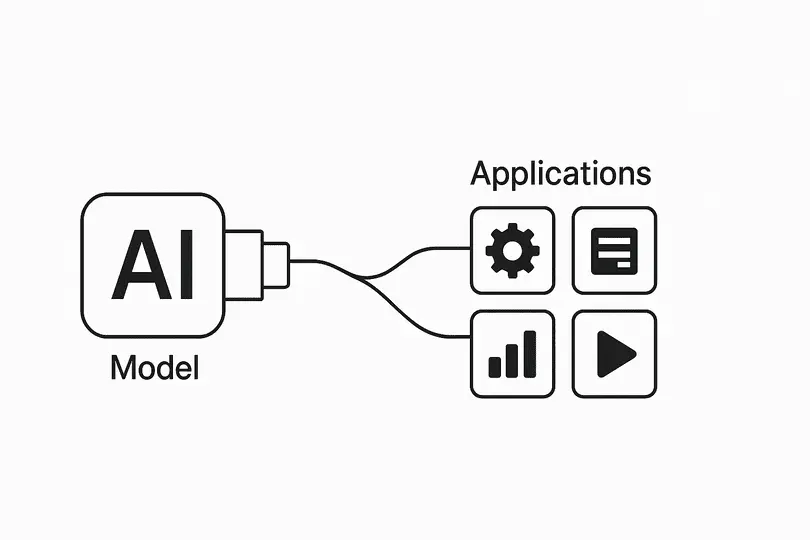MCP (Model Context Protocol): The New Standard for AI Agent Collaboration

As artificial intelligence continues to evolve, we’re witnessing a shift from passive language models to agentic AI systems—autonomous programs that can perceive, plan, and act in dynamic environments. These AI agents are capable of executing complex tasks independently. (If you're unfamiliar with this concept, check out our article for a quick introduction.)
But for AI agents to function effectively in real-world scenarios, they must go beyond their training data and interact with external tools and information sources. This is where MCP, or the Model Context Protocol, enters the picture.

What Is MCP and Why Does It Matter?
MCP, short for Model Context Protocol, is a standardized interface introduced by Anthropic in late 2024 to bridge AI agents and the external world. Traditionally, enabling a language model to access tools like APIs, databases, or other systems required building custom connectors—often brittle, repetitive, and difficult to scale.
With MCP, AI agents can interact with various external systems—tools, services, databases—through a unified and open protocol. Think of MCP as the USB-C for AI: one standard that allows seamless communication between different models and external components.
Technically, MCP defines how an AI agent (the client) can send structured requests to an MCP server (the provider of external tools or services), which processes the task and returns a structured response. The AI model doesn't need to know the backend details—it simply follows the protocol, and the server handles the execution.
This standardization removes the need to build N × M integrations between each model and each tool. Instead, you just connect your model and your tools once—to the MCP protocol—and you're ready to scale.
From Theory to Practice
Let’s say you have a language model that needs to search a customer database, query a calendar, or trigger an internal workflow. With MCP, these actions are standardized. The model can simply send a request like: "fetch user record from CRM" and MCP will route this to the appropriate connector and return the data.
MCP doesn’t provide any logic or decision-making by itself—it’s not an agent framework or a planner. Instead, it’s the plumbing that allows agents to access and operate tools efficiently. This makes it highly modular and composable with other architectures.
One of the most significant benefits of MCP is that it’s model-agnostic and open-source. While it was introduced by Anthropic, any LLM—OpenAI's GPT, Meta's LLaMA, Mistral, or open-source models—can use MCP to access tools. This openness makes MCP rapidly adoptable.
In fact, by early 2025, a growing number of companies such as Block, Replit, and Sourcegraph had adopted MCP. Community developers had already published over 1,000 MCP-compatible servers—connectors to popular APIs and platforms.
MCP and Multi-Agent Collaboration
Where MCP truly shines is in multi-agent systems. These are environments where multiple AI agents work together—each handling a specific subtask while communicating with others. This modular structure has immense potential in enterprise and operational use cases.
For example, imagine three AI agents working on a task:
- One agent conducts research,
- Another creates a plan,
- A third executes the actions.
Using MCP, all these agents can access the same shared toolset and data context. They no longer operate in silos or require separate APIs. This enables smooth hand-offs, real-time collaboration, and unified workflows.
More importantly, this reduces hallucinations and propagation of errors. When agents draw from the same real-time sources via MCP, they are less likely to operate on outdated or fabricated data. The result is a more accurate, reliable, and scalable AI system.
Use Cases Across Industries
MCP is not just a technical protocol—it’s a foundation for AI-enabled transformation across industries. Here’s how it could make a difference:
Human Resources (HR)
AI agents powered by MCP can streamline recruitment workflows. One agent can screen résumés, another can schedule interviews via calendar integration, while another communicates with the candidate—all accessing the same HR database and tools through MCP. This speeds up the hiring process and minimizes errors.
Manufacturing
In smart factories, MCP-enabled agents can predict machine failures from IoT sensor data, order parts from ERP systems, and coordinate maintenance—all in real-time. By facilitating agent-to-system collaboration, MCP becomes a critical part of Industry 4.0 and 5.0.
Customer Support
Imagine a support chatbot using MCP to query a CRM for a customer’s history, check inventory systems for product availability, and issue a return order—all autonomously. Instead of being a standalone bot, the agent becomes an intelligent interface to the company’s operations.
Software Development
MCP enables agent-based collaboration in development workflows. One agent writes code, another tests it, and a third documents it—while all interact with repositories, issue trackers, and build systems through the same protocol. This modular approach accelerates software delivery and improves quality.
Why MCP Is a Big Deal
- Standardization: One protocol to access many tools, reducing duplication and increasing interoperability.
- Scalability: Instead of coding dozens of unique tool integrations, developers can focus on building more capable agents.
- Ecosystem Growth: With thousands of public MCP servers already available, developers can immediately connect their agents to a wide range of tools and services.
- Open Innovation: Because MCP is open-source and community-driven, it evolves rapidly and democratically—similar to successful protocols like HTTP or USB.
MCP is likely to become a de facto standard for AI agent interoperability.
Looking Ahead
MCP represents a shift in how we think about AI: not as isolated models, but as collaborative agents embedded in real-world systems. By offering a consistent and extensible way for agents to interact with tools, MCP empowers them to move beyond static prompt-response behavior and become active participants in business workflows.
While MCP is still in its early stages, its adoption is growing fast. Enterprises looking to deploy AI in production environments—across HR, operations, customer service, or software—should keep a close eye on this emerging standard.
Understanding MCP today means building AI systems tomorrow that are modular, reliable, and future-proof.
Resources:- Anthropic. “What Is MCP, and Why Is Everyone – Suddenly! – Talking About It?” Hugging Face, March 17, 2025. – A detailed community article on the emergence and significance of MCP. Available at: huggingface.co
- LLMhacker. “MCP is All You Need: The Future of AI Interoperability.” Hugging Face, 2025. – A comprehensive analysis of MCP’s technical foundation and its role in the AI ecosystem. Available at: huggingface.co
- Gao Dalie. “LangGraph + MCP + Ollama: The Key To Powerful Agentic AI.” Medium, March 28, 2025. – An evaluation of MCP’s practical use from a developer's perspective. Available at: medium.com
- IBM. “What are AI agents?” IBM Think Blog, July 3, 2024. – An introductory article on the definition and operational principles of AI agents. Available at: ibm.com
- Tran et al. “Multi-Agent Collaboration Mechanisms: A Survey of LLMs.” arXiv, January 2025. – An academic review on collaboration strategies in multi-agent systems based on large language models and their applications across various sectors. Available at: arxiv.org
- Kseniase K. “New Possibilities Unlocked by MCP.” Hugging Face, 2025. – An overview of MCP's role in multi-agent orchestration and potential new use cases (e.g., agent communities, personal assistant integration). Available at: huggingface.co
Notification!




